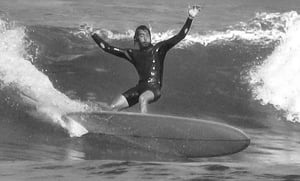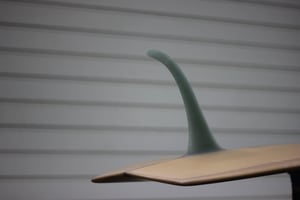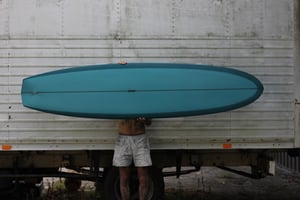V-Bottom 8'2
1.360,00 €

From 7'6 to 9'
A planing surface divided into two at the tail, offering two different angles, provides the same displacement as a convex bottom while providing the advantages of a planing bottom (flat).
I oriented my design towards a more extreme version of Vee-bottom by accentuating the difference between the nose and the tail and removing the outline of the parallel rails.
A parallel outline over too great a length can make turning or changing direction difficult and "long". A more "disproportionate" outline with an accentuated width from the wide point to the tail of the board will increase the pivot point at the back foot and help with tighter turns.
Likewise, with a more refined nose, the board will be more manoeuvrable.
The extremely deep vee, revealing two distinct flat surfaces, is pushed up to 3 feet from the tail, a little above the fin. The bottom shape then evolves into a flat surface, located in the middle of the board. It is also where the widest and thickest point coincide. It is therefore the key position on the board where the surfer will be when he goes into "trim" mode. Thanks to the extreme vee panels, the surfer will be able to stay on this sweet spot with his feet together, while steering the board thanks to "heel and toe" pressures.
It is only for cutbacks that the surfer can move his foot back slightly towards the fin to radically swing the board from one rail to another. An extremely deep fin of 11 Inches, with total flex due to the volan and the narrow tip, will allow the wide tail not to slide and above all will offer a substantial lift, which will allow the surfer to regain his line after each cutback.
I analyzed that a deep vee located at the tail on tight and low rocker tails caused a braking effect due to excessive water dragging. (As with hot curls, but which in this case, was put to good use to compensate for the non-existent fin.) I then started shaping my vee-bottoms with neutral rockers, but turning the blanks back to front and shaping my tails in the nose of the blank and my nose in the tail of the blank. So using the rocker of a nose for my tail, thus allowing me to have a kicktail, which would therefore be enabling the deepest part of the vee to be out of the water. The vee would then only be in the water when needed, once the surfer moves his foot back towards the fin. Once the surfer returns to the sweet spot, in the middle of the board, on the flat surface and no longer using the vee, it would be once again out of the water thanks to the kicktail.




